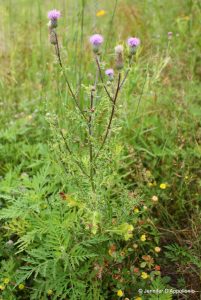Lesson 4. Weed Control in Pastures

Weed control in pastures can be a very difficult challenge. This is especially true in certain cases where animal species select against specific weed species (example: horses — tansy; cows — goldenrod, thistles, and milkweed). This is a common occurrence in all livestock grazing systems.
Plant species are unique in livestock grazing systems as compared to row crops. It is important to remember there are several plant species that are considered weeds in a row crop operation, but possess characteristics that are beneficial in a grazing system. Some of these include quackgrass, lambsquarter, and others. These plants, if properly managed can take abuse, yet still produce high quality, palatable forage. Therefore, we should focus on the plants that animals avoid eating and those containing low nutritional value such as thistles and goldenrod.
It is important to begin by scouting pastures to identify all pre-existing problems. References, such “Weeds of the Northeast” (see Appendix A), can help you identify noxious and poisonous plants. Problem areas, “hot spots,” tend to be found where animals congregate (under trees and around water tanks, etc.) or where animals tend not to graze (rock piles, steep slopes, along fence lines, etc.). This will then, in turn, help you in developing a plan to eliminate weed problems and keep from developing new ones. Your local UMaine Extension educator can help with this process.
| Common Name | Genus and species |
|---|---|
| Bracken Fern | Pteridium aquilinum |
| Burdock, Common | Arctium minus |
| Buttercup | Ranunculus bulbosus L. |
| Cherry, Common Chokecherry | Prunus virginiana |
| Dogbane | Apocynum cannabinum |
| Ivy, poison | Toxicodendron radicans |
| Loosestrife, purple | Lythrum salicaria, virgatum, or any combination |
| Milkweed | Asclepias syriaca |
| Spurge, leafy | Euphorbia esula |
| Bedstraw, smooth | Galium mullugo L. |
| Sowthistle, perennial | Sonchus arvensis |
| Thistle, bull | Cirsium vulgare (biennial) |
| Thistle, Canada | Cirsium arvense (perennial) |
